预约演示
更新于:2025-09-09

Central China Normal University
更新于:2025-09-09
概览
标签
感染
肿瘤
神经系统疾病
小分子化药
预防性疫苗
单克隆抗体
疾病领域得分
一眼洞穿机构专注的疾病领域
暂无数据
技术平台
公司药物应用最多的技术
暂无数据
靶点
公司最常开发的靶点
暂无数据
| 排名前五的药物类型 | 数量 |
|---|---|
| 小分子化药 | 7 |
| 预防性疫苗 | 3 |
| 单克隆抗体 | 1 |
| 偶联药物 | 1 |
关联
11
项与 华中师范大学 相关的药物作用机制 钾离子通道阻滞剂 |
在研机构 |
原研机构 |
在研适应症 |
非在研适应症- |
最高研发阶段临床申请批准 |
首次获批国家/地区- |
首次获批日期- |
14
项与 华中师范大学 相关的临床试验ChiCTR2400092939
Experiential Avoidance and Depressive and Anxiety Symptoms from a Transdiagnostic Perspective: Association, Mechanisms, and Internet-Based Intervention
开始日期2024-11-30 |
申办/合作机构 |
ChiCTR2400095048
The effect of depressive tendency on reward processing in college students: an event-related potential study and a randomized controlled intervention
开始日期2024-10-20 |
申办/合作机构 |
ChiCTR2500099805
Research on the Identification of Depression Status and Prediction of Intervention Effects in College Students Based on Event-Related Potentials and Machine Learning
开始日期2024-10-01 |
申办/合作机构  华中师范大学 华中师范大学 [+1] |
100 项与 华中师范大学 相关的临床结果
登录后查看更多信息
0 项与 华中师范大学 相关的专利(医药)
登录后查看更多信息
10,057
项与 华中师范大学 相关的文献(医药)2026-01-01·PSYCHOLOGY OF SPORT AND EXERCISE
Optimizing exercise for perinatal depressive symptoms: A network meta-analysis of effective modalities and doses
Review
作者: Xie, Jingyi ; Jin, Mingyuan ; Wang, Bin
BACKGROUND:
While exercise is a promising strategy for alleviating perinatal depressive symptoms, its clinical potential remains unrealized due to ambiguity in optimal modalities and dosages, hindering targeted clinical prescription and the design of effective interventions. This study aimed to identify the most effective exercise type and dosage for reducing perinatal depressive symptoms severity.
METHODS:
Randomized controlled trials (RCTs) evaluating exercise for perinatal depressive symptoms were identified from four databases (from inception to November 2024). A comprehensive comparison of the effectiveness of various exercise modalities in alleviating perinatal depressive symptoms was conducted using a combination of network meta-analysis (NMA) and dose-response meta-analysis.
RESULTS:
A total of 46 RCTs involving 5719 participants were included. In the NMA, Pilates ranked highest for reducing perinatal depressive symptoms, showing a marked effect [SMD = -1.25, 95 % CrI: (-2.14, -0.364)]. Yoga, aerobic exercise, and flexibility training followed, also showing notable effects. The optimal dose for substantial benefits was identified as approximately 360 MET-min/week. This is practically equivalent to engaging in two 30-min sessions per week for a duration of 12 weeks.
CONCLUSIONS:
Our findings conclude that exercise modalities like Pilates and yoga are highly effective for alleviating perinatal depressive symptoms when prescribed at an optimal dose of approximately 360 MET-min/week. This is practically achievable through two 30-min sessions weekly for 12 weeks. These findings provide clinicians with actionable, evidence-based guidance for prescribing exercise to this population. Future research should prioritize head-to-head trials comparing leading modalities, such as Pilates and yoga, to further refine therapeutic guidelines.
2026-01-01·JOURNAL OF AFFECTIVE DISORDERS
Anxiety, depression and family resilience: A three-level meta-analysis
Article
作者: Ren, Zhihong ; Wu, Donghong ; Mi, Tingni ; Henry, Carolyn S ; Li, Ying ; Li, Rui ; Jia, Siyao ; Du, Xiayu
BACKGROUND:
Perceived family resilience, which refers to the subjective assessment of family members regarding their family's ability to effectively adapt and maintain stability during challenging times, has been negatively correlated with mental health issues such as anxiety and depression in numerous studies; however, the strength of this association has varied significantly across previous research. This study fills this gap through a three-level meta-analysis.
METHOD:
This study aims to obtain reliable estimates of effect sizes and explore potential moderating factors in the relationship between perceived family resilience and symptoms of anxiety and depression. Through a systematic literature search, twenty studies reported on the relationship between perceived family resilience and symptoms of anxiety and depression, encompassing 125 effect sizes and 18,283 participants. Perceived family resilience, referring to individual participants' subjective assessment of their family's resilience, along with anxiety and depression symptoms, was assessed using validated self-report questionnaires. Employing a three-level model, this three-level meta-analysis was conducted based on the Preferred Reporting Items for Systematic Reviews and Meta-Analyses (PRISMA) approach.
RESULTS:
Findings indicated a significant negative correlation between perceived family resilience and symptoms of anxiety and depression (main effect: r = -0.31, p < 0.001), with notable variations due to education level, anxiety-depression outcome type, type of measurement for anxiety and depression, and nuclear family structure.
LIMITATIONS:
The limited number of studies, reliance on self-report measures, cross-sectional designs, and variable study quality restrict generalizability, causal inference, and the understanding of underlying mechanisms.
CONCLUSION:
The study confirms that higher perceived family resilience is associated with lower symptoms of anxiety and depression, highlighting its protective role in mental health.
2026-01-01·JOURNAL OF COLLOID AND INTERFACE SCIENCE
Super-amphiphilic adjuvants for enhancing the spreading and deposition performance of pesticide on corn leaves in high-temperature conditions
Article
作者: Ma, Cuiguang ; Liu, Yuchao ; Su, Chenyu ; He, Qiang ; Zhang, Haifan ; Zhao, Zhihang ; Zhou, Zihao ; Li, Haibing ; Qu, Haonan ; Bahojb Noruzi, Ehsan
This research introduces an interesting approach to improve pesticide delivery to corn leaves during hot climates by developing super-amphiphilic adjuvants through amino pillar[5]arene (AP5A) and cetyltrimethylammonium bromide (CTAB) complexation. The AP5A-CTAB adjuvant functions to improve droplet retention along with spreading capabilities for resolving limitations that exist in small molecule adjuvants. The AP5A-CTAB host-guest complexation was confirmed by UV-Vis, NMR spectroscopy, and Gaussian calculations. The spreading and wetting capabilities measured on corn leaves by contact angle showed that the complex performed better than its components. Simultaneous high-speed camera imaging revealed that the biophysical properties of the adjuvant could be used to robustly regulate droplet impact behavior, such that wetting and deposition were effective even on inclined leaf surfaces. Additional analysis showed that the AP5A-CTAB complex has less surface tension than its components, rapidly spreading over the leaf surface. Resistance to droplet splitting during impact was achieved by increasing its viscosity, which improved its effectiveness. The enhanced solubility and loading efficiency were confirmed using Nile Red as a marker. Additional experiments further validated the adjuvant's loading capacity toward Flubeneteram, improving retention and antibacterial efficacy against corn anthracnose and sheath blight.
17
项与 华中师范大学 相关的新闻(医药)2025-07-10
·精准药物
近日,欧洲科学院(Academia Europaea)官网更新2025年院士名单。目前已有329名杰出学者当选为2025年欧洲科学院新当选院士。由于入选学者接受邀请及注册的时间进度不同,入选名单陆续公布。截至目前,已至少新增7位学部归属均为基础和临床转化科学学部的华人学者当选2025年欧洲科学院院士,分别为西湖大学讲席教授、校长助理裴端卿、西南医科大学党委书记张春祥、福建医科大学副校长叶为民、温州医科大学院长张康、香港中文大学院长赵伟仁、香港城市大学教授黃聿、香港大学教授梁伟强。此前已有西湖大学国强讲席教授、副校长仇旻、南京师范大学教授陈旻、中国科学院及深圳理工大学材料与能源学院名誉院长教授成会明、澳门大学特聘教授李德凤、中山大学教授龙海平、中国科学院苏杭研究员、浙江大学教授王贵国、西南大学材料与能源学院院长教授王中长、河北大学教授叶金花、中国科学院大学教授宗成庆、中国科学院大气物理研究所大气环境和极端气象重点实验室主任苏杭、等华人学者当选欧洲科学院院士。值得注意的是,西湖大学此次有西湖大学国强讲席教授、副校长仇旻;讲席教授、校长助理裴端卿,两位教授当选欧洲科学院院士。名单如下:欧洲科学院(Academia Europaea)是欧盟的“国家科学院”和法定科学顾问,由英国皇家学会等多个代表欧洲国家最高学术水平的国家科学院于1988年共同发起成立,总部位于英国伦敦。作为国际上学术领域最广泛、学术地位最高、影响最大的科学组织之一,欧洲科学院院士主要在欧洲各国的院士中遴选,外籍院士通过率不超过5%,是一项崇高的国际学术荣誉。裴端卿裴端卿,西湖大学生命科学学院讲席教授,西湖大学校长助理。于1984年获得华中农学院(现华中农业大学)学士学位;1991年获得美国宾夕法尼亚大学博士学位,1991至1996年,在美国密西根大学医学院从事博士后研究,1996年9月至2004年7月在美国明尼苏达大学医学院药理系,历任助理教授、副教授(Tenured)。2002年回国,受聘于清华大学;2004年8月受聘于中国科学院广州生物医药与健康研究院,曾任副院长、院长、研究员、博导;2015年10月起,开始筹建广州再生医学与健康广东省实验室;2020年5月加入西湖大学。裴端卿教授回国后开始细胞命运调控研究,以诱导多能干细胞(iPSC)作为实验模型,建立并优化了iPS研究平台技术;发现:维生素C促进iPSC诱导效率;EMT/MET驱动体细胞重编程;人尿液上皮细胞为起始细胞的多能干细胞/神经干细胞;并提出了细胞命运调控中染色质开-关的二元转变机制与多能/体细胞间的介面假说,这些发现与假说继续指导更加广泛的细胞命运转变机理研究。仇旻仇旻,国家杰出青年基金获得者,现任西湖大学国强讲席教授、副校长、西湖大学工学院院长、西湖大学光电研究院院长,美国光学学会会士(Optica Fellow)、国际光学工程学会会士(SPIE Fellow)、电气和电子工程师协会会士(IEEE Fellow)、中国光学学会会士(COS Fellow)、中国光学工程学会会士(CSOE Fellow)、中国光学工程学会常务理事、浙江省光学学会副理事长、浙江省物理学会副理事长、浙江省电子学会副理事长、浙江省机械工程学会激光制造增材制造分会副理事⻓。曾任美国光学学会理事会(扩大)理事。1995年和1999年获浙江大学理学学士和凝聚态物理博士学位,并于2001年获得瑞典皇家理工学院电磁理论工学博士。2001年被聘为瑞典皇家理工学院助理教授,2005年晋升副教授,2009年晋升为光子学正教授。曾获“瑞典战略研究基金会”资助的“未来科研带头人”基金、瑞典国家科学研究基金会高级研究员专门基金等。2010年任浙江大学光电科学与工程学院教授,曾任浙江大学现代光学仪器国家重点实验室主任。2018年加入西湖大学。赵伟仁赵伟仁现任香港中文大学医学院院长、信兴教育及慈善基金机械人外科教授、上消化道外科及代谢外科教授、医疗机械人创新技术中心主任,以及中大消化疾病研究所内镜中心总监。赵教授亦是香港特区政府医务卫生局医疗创新发展督导委员会成员,医院管理局董事局成员,并于2021-2023年出任亚洲内视镜与腹腔镜外科医学会(ELSA)会长。赵教授于1994年毕业于香港中文大学医学院,2001年成为香港医学专科学院院士,爱丁堡皇家外科医学院院士(外科),并于2009年获得香港中文大学医学博士学位。赵教授是内镜机械人手术的先驱,积极推动医疗创科发展。其研究领域包括食管癌治疗、微创和机械人食管切除术、用于诊断和治疗早期胃肠癌的新型内镜技术、内镜手术,以及腔内手术的机械技术。他发表了近400篇论文和6本书籍章节,目前担任《Endoscopy》编委。赵教授的研究成果屡获奖誉,包括国家科学技术进步奖(2007) 及教育部技术进步二等奖(2011)、美国消化疾病周最佳论文(2011) 、美国胃肠镜内镜世界杯内窥镜检查一等奖(2012)、亚太消化周新领袖(2016) 、日内瓦国际发明展评判嘉许特别金奖(2019及2023)、香港(创新)精神奖(2020) 、欧洲内镜外科协会名誉会员(2023) 及伦敦帝国学院哈姆林医疗机械人研讨会「卡尔史托斯-哈罗德霍普金斯金内镜奖」(2023) 等。黃聿黄聿是香港城市大学生物医学胡梁子慧生物医学教授、生物医学和血管生物学讲座教授、生物医学系系主任。他于复旦大学上海医学院获得学士学位,并于剑桥大学获得博士学位。在2021年加入香港城市大学之前,他是香港中文大学生物医学A3级讲座教授,也是心血管研究所的创始所长(基础科学)。黄聿教授是心血管疾病全国重点实验室学术委员会委员。于2025年当选为欧洲科学院外籍院士。先后被12所大学和研究所聘为客座教授,其中包括复旦大学上海医学院、中国科学技术大学、澳门大学、马来亚大学、上海交通大学医学院、北京大学基础医学院、西安交通大学医学院。黄教授团队的研究聚焦于高血压、肥胖和糖尿病等疾病中引发内皮细胞功能障碍的细胞和分子生物学过程,旨在发现血管发病机制的新型生物标志物,从而在血管-代谢紊乱疾病动物模型中开发能够逆转血管功能障碍的新途径。曾荣获由国际心脏研究学会颁发的2024年度Peter Harris杰出科学家奖、中国病理生理学会血管医学专业委员会杰出贡献奖(2021)、2020年度药明康德生命化学研究奖、由教育部颁发的高等学校科学研究优秀成果奖(2019年度自然科学奖一等奖、2012和2017年度自然科学奖二等奖)、国家自然科学奖二等奖(2015)等。梁伟强梁伟强,肠胃病专家,现为李树芬医学基金肠胃病学教授及香港大学临床试验中心主任。香港中文大学内外全科医学士,香港中文大学医学博士。他于2018年至2024年期间出任香港大学李嘉诚医学院研究副院长。梁教授现任Helicobacter杂志主编、前任香港肠胃病学会会长(2022-2024年)和亚太胃肠病学协会财务主管(2023-2025)。梁教授对胃肠病学和内窥镜检查有着广泛的研究兴趣,包括幽门螺杆菌和胃癌发生、炎症性肠病、人工智能和筛查结肠镜检查。梁教授以第一作者或通讯作者身份在Lancet系列、Gastroenterology、Gut、Nature Communications等顶级医学和胃肠病学期刊上发表原创文章330余篇。张春祥张春祥,心血管内科学博士、留美心血管药理学博士后、博士生导师、国家海外高层次引进人才、心脏内科二级教授/主任医师、西南医科大学党委书记、西南医科大学教育部医学电生理学重点实验室主任、教育部代谢性心血管疾病医药基础研究创新中心主任、中国医师协会整合医学分会会长、中国医药教育协会智能心血管病学专业委员会主任委员、中国高等教育学会医学教育专委会常务理事、高等院校创新健康科普联盟理事长、四川省卫生健康首席专家。张春祥教授长期从事心血管疾病及心血管药理学方面的研究。其在国际上率先开展非编码RNA与心血管疾病的研究,是这一领域国际公认的开拓者和领军人物,在此领域作出了系列原创性贡献。出国前曾在青岛医学院附属医院、广东省人民医院及香港中文大学威尔斯亲王医院等工作10年。1998-2019年,在美国几个大学医学院先后任助理教授、终身教职副教授、正教授至大学首席讲席教授 (The Deborah R and Edgar D. Janotta Presidential Professor)。在美国工作22年期间,长期担任美国科学学位研究生(PhD)、医学生(MD)、医学双博士生(MD/PhD)、住院医生(Resident)和专科医生(Clinical Fellow)的教学与培养工作。先后任美国大学研究中心主任、研究所所长、大学系主任等。曾长期担任美国心脏病学院芝加哥区理事、国际转化医学学会会议委员会主席、北美华人药理学会会长、美国恩科心血管研究院秘书长等。任转化医学杂志副主编、心血管再生医学杂志副主编及其它18个国际杂志编委。长期担任美国国立卫生院(NIH)、美国老兵部(VA)、瑞士自然科学基金,意大利卫生部等10个国际机构的基金评委。2019年全职回国工作,是四川省学术和技术带头人、享受国务院特殊津贴。长期担任国家自然科学基金重点项目、国家杰青等评审专家。叶为民叶为民,瑞典卡罗琳斯卡医学院终身教授,国家级人才计划专家。自2018年引至福建医科大学,任副校长,并兼任公共卫生学院院长、群体医学研究院院长。2021年任福建省海峡肿瘤防治科技交流协会会长、中华预防医学会肿瘤预防与控制专委会副主任委员、中国医药生物技术协会组织生物样本库分会委员。主要研究方向为肿瘤流行病学与病因学研究,领导和参与了国内外多项大型队列的建设,包括福建队列、泰州队列、瑞典NMC队列、欧洲营养与肿瘤大型前瞻性队列等,在流行病学领域具有深厚的研究基础。领导的流行病学团队注重现场与实验室的紧密结合,在流行病学领域具有深厚的研究基础,在慢性病病因学研究上拥有多项成果与丰富经验。相关研究成果在BMJ、JAMA Oncology、Gastroenterology、Gut等期刊发表。张康张康教授,哈佛大学医学博士、哈佛医学院-麻省理工学院联合医学博士、哈佛大学生化和药理博士,欧洲科学院院士、美国科学促进会会士、美国医学与生物工程院会士、英国皇家医学会会士、英国皇家化学会会士。现任世界华人眼科医师协会会长,温州医科大学附属眼视光医院国家眼部疾病临床医学研究中心首席科学家、温州医科大学眼健康与疾病高等研究院院长、温州医科大学眼科创新与转化研究院院长、温州医科大学临床大数据研究院院长。在眼科学、医学人工智能、肿瘤、分子遗传学及精准医学领域拥有很高造诣,WOS收录文章超400篇,其中在Nature、Science、Cell、New England Journal of Medicine等顶级期刊发表近300篇,总引用量超80000次,H指数114。2019-2024连续6年入选“全球跨学科高被引学者”,获世界华人医师协会霍英东奖等荣誉。在眼科疾病领域,发现黄斑变性关键易感基因(获评Science年度科学十大突破),成果用于全球基因检测;阐明羊毛甾醇于白内障形成的核心机制,为非手术药物治疗开辟新途径。再生医学领域,全球首创诱导干细胞修复角膜及内源性干细胞介导的组织功能性再生(获评Nature Medicine年度医学八大进展),革新致盲眼病治疗方法;并建立异种器官移植免疫反应的创新评估模型。在表观遗传学领域,全球首次通过大规模DNA甲基化分析深刻揭示了生物学年龄及肿瘤的分子特征及其对健康和疾病的深远影响,为衰老评估、肿瘤早筛及相关疾病干预提供了重要科学依据和全新视角,成果在全球广泛推广应用;医学人工智能领域,领导开发EyeGPT、MetaGP等智能化诊疗平台,率先将先进AI技术应用于医学影像和电子病历分析与疾病精准分类 (获评Cell最佳年度论文和最佳交叉论文);研发全球首个通用合成医疗数据生成和应用平台,主导成立全球首个医疗数字孪生联盟并发布国际首部医疗AI临床应用指南,推动智慧医疗的创新与标准化。此前已公布名单:陈旻陈旻,南京师范大学地理科学学院教授、美国地理学家协会会士。2000年至2004年就读于南京师范大学计算数学专业,获学士学位;2004年至2009年继续在该校攻读地图学与地理信息系统专业,获博士学位。2009年至2012年赴香港中文大学太空与地球信息科学研究所从事博士后研究,2012年至2015年担任该所副研究员。2015年任职于南京师范大学地理科学学院,2019年起担任虚拟地理环境教育部重点实验室副主任。其主要研究方向为地理建模与模拟、虚拟地理环境,在该领域取得了丰硕成果,先后荣获自然资源科技奖、中国地理学十大研究进展、地理信息科技进步奖特等奖以及全球前沿科技青年科学家奖等多项重要学术荣誉。成会明成会明,中国科学院深圳先进技术研究院碳中和技术研究所所长,深圳理工大学材料与能源学院名誉院长,中国科学院金属研究所沈阳材料科学国家研究中心先进炭材料研究部主任。1980年,进入湖南大学化工系碳素专业学习。1984年,考入中国科学院金属研究所,先后获得工学硕士学位(1987)、工学博士学位(1992)。1990—1992年,作为联合培养的博士生,在日本通产省工业技术院九州工业技术研究所学习。2013年当选为中国科学院院士,2014年当选为发展中国家科学院院士。主要从事碳纳米管、石墨烯与其他二维材料、新型能源材料的制备、性能及应用等研究。相关成果获发明专利280余项,发表论文890余篇,H因子165,被科睿唯安评选为化学、材料、环境与生态学三个领域的国际高被引科学家。曾担任1项973项目和2项国家纳米重大研究计划项目首席科学家、国家自然科学基金委创新研究群体项目负责人(连续三届)和“六元环无机材料”基础科学中心负责人。曾获国家自然科学二等奖3项、国防科技进步二等奖、何梁何利科学与技术进步奖、美国碳学会Charles E. Pettinos奖、德国SGL集团Felcht奖、美国化学会ACS Nano讲座奖等奖励。 李德凤李德凤,澳门大学翻译学教授、人文学院副院长,翻译传译认知研究中心(CSTIC)主任。1983年至1987年就读于南京师范大学英语语言文学专业,获学士学位;1987年至1990年继续在该校攻读翻译学硕士;1994年至1997年赴加拿大阿尔伯塔大学深造,获第二语言教育博士学位。他具有丰富的国际学术经历,曾在伦敦大学亚非学院任教并担任翻译研究中心主席,在香港中文大学翻译系任教十年,2006年至2011年期间还担任山东大学外国语学院院长及上海交通大学翻译学访问讲座教授。李德凤长期致力于翻译认知研究,主要研究方向包括翻译过程的神经认知与心理语言学机制、语料库翻译学,以及翻译教育的课程与教材开发。现任世界口译和笔译培训协会(WITTA)主席、国际翻译、口译与认知协会(IATIC)主席、中国语料库翻译研究协会和中国认知翻译研究协会副会长、太平洋计算机辅助语言学习协会副主席等。其在翻译学领域著述丰富,发表多部学术专著及大量高水平论文,对推动翻译学科发展做出了重要贡献。龙海平龙海平,中山大学外国语学院英语系教授,洪堡资深研究员(Humboldt Experienced Researcher)。1993年至1997年就读于中国矿业大学英语语言文学专业,获学士学位;1997年至2000年继续在该校攻读硕士学位;2004年至2007年在华中师范大学获语言学及应用语言学博士学位;2007年至2010年在广东外语外贸大学从事博士后研究。其学术生涯始于深圳职业技术学院,曾任外事处职员及应用外国语学院副教授,后任职于广东外语外贸大学英文学院,历任副教授、教授,2016年9月起受聘为中山大学教授。龙海平长期致力于语法学与语言类型学研究,学术成果丰硕,曾获第十九届中国社会科学院吕叔湘语言学奖二等奖、广东省第八届哲学社会科学优秀成果奖二等奖等重要学术奖项。苏杭苏杭,中国科学院大气物理研究所大气环境和极端气象重点实验室主任,美国科学促进会(AAAS)会士。1999—2003年就读于复旦大学获学士学位,2003—2008年在北京大学获得博士学位。2008—2012年在德国马克斯普朗克化学研究所从事博士后研究,2013—2023年在该所担任首席研究员和实验室主任,2023年起任现职。苏杭长期致力于大气化学与物理研究,在大气氧化性、气溶胶与云相互作用等前沿领域取得了一系列突破性成果。其学术成就获得国际学界广泛认可,先后荣获欧洲地球科学学会Arne Richter杰出青年科学家奖(学会级),连续三年(2021-2023)入选科睿唯安“全球高被引科学家”(地球科学领域)。其代表性研究成果入选中国科学院《科学发展报告》“中国科学家具有影响力的部分工作”(19项之一),单篇论文Altmetric影响力指数高达9500(位列Science期刊全球前十),充分展现了其在国际大气科学领域的学术影响力与引领地位。王贵国王贵国,浙江大学光华法学院文科资深教授、博士生导师,现任浙江大学国际战略与法律研究院院长、“一带一路”国际研究院(香港)院长,中华人民共和国最高人民法院国际商事法庭专家委员会委员,第十二届、第十三届全国政协委员。作为中国国际法学界的领军学者,王贵国1981年获北京大学法律系法学硕士学位,1982年获美国哥伦比亚大学法学硕士学位,1984年成为中国大陆首位获得耶鲁大学法哲学博士学位的学者。早年曾在美国、加拿大知名律师事务所执业,是中国首位获得联合国培训与科研研究所奖学金的学者,1980年赴联合国国际法院、海牙国际法学院等国际机构学习考察。其学术生涯跨越两岸三地,先后任教于北京大学法学院、香港城市大学法学院和浙江大学光华法学院,历任首席讲师、教授、讲座教授等职。现任比较法国际(海牙)科学院院士、香港世界贸易组织研究中心主席、中国国际经济法学会副会长等多项重要学术职务,同时担任中国国际经济贸易仲裁委员会专家咨询委员会委员、仲裁员,香港申诉专员名誉法律顾问等实务职位。王贵国学术成果丰硕,出版专著、编著20余部,发表学术论文百余篇,在国际经济法、比较法等领域具有深远的学术影响力。王中长王中长,西南大学材料与能源学院院长,北京航空航天大学化学学院特聘教授,欧洲国际纳米技术研究所高级研究员。2008年获日本东京大学博士学位后,先后在日本东北大学担任助手、助理教授(2008—2012)和副教授(2013—2017)。2016年任英国伦敦大学学院访问教授,2017年起担任欧洲国际纳米技术研究所课题组长。2019-2023年任欧盟伊比利亚国际纳米技术实验室(INL)苏州开放创新中心主任,2023年起任INL科学助理。王中长长期致力于新型低维、纳米及能源材料的原子层面研究,在材料制备、表征、性能测试及理论计算(第一性原理和分子动力学)方面具有深厚造诣。其研究重点聚焦于材料原子电子结构与物理化学性能的构效关系,特别是在功能缺陷、量子输运及多铁性能等领域取得突破性进展,并成功开发出新型超薄功能器件。作为项目负责人,主持了20余项包括中国国家自然科学基金、欧洲研究经费和日本文部省科研费在内的重大科研项目。王中长在国际知名期刊发表SCI论文280余篇,研究成果荣获国际材料晶界与相大会年轻科学家奖、日本材料学会材料研究促进奖、国际材料联合会年轻科学家奖、NEC最高科学技术奖、IAAM奖等多项国际殊荣,并获得中国国家杰出青年基金和重庆市巴渝学者等国内重要人才称号。相关成果被朝日新闻、读卖新闻、日本经济新闻、东京新闻等日本及欧洲媒体宣传,在学术界和社会层面均产生重要影响。叶金花叶金花,河北大学物理科学与技术学院教授,天津大学特聘教授,“先进催化材料研究中心”主任,河北大学“光驱动碳中和研究中心”主任。1983年于浙江大学获学士学位,1990年于东京大学获理学博士学位。长期从事新型纳米光催化材料的开发以及在太阳能转换和环境净化方面应用的研究,先后承担了日本政府、产业界、国家“973”项目以及国家自然科学基金重点基金等十几项重大研究项目。2005年入选长江学者奖励计划讲座教授,2006年获得海外杰出青年基金,2010年入选国家海外高层次人才计划。2016年入选英国皇家化学会会士,2016年起连续多年入选为全球高被引科学家。历任日本国家材料研究所(NIMS)主席研究员,光催化研究中心主任,环境再生材料研究中心主任,国际纳米材料研究据点首席研究员,北海道大学化学院教授,以及天津大学—NIMS联合研究中心主任。现任Science Advances和ACS Nano副主编。已在Nature, Nat. Mater., Nat. Catal., Nat. Commun., J. Am. Chem. Soc., Adv. Mater.等国际学术杂志上发表论文700余篇,获得同行引用66,000余次,H因子134。宗成庆宗成庆 ,研究员,博士生导师,中国科学院大学岗位教授(A类),电气与电子工程师协会会士(IEEE Fellow),国际计算语言学学会会士(ACL Fellow),亚太人工智能学会会士(AAIA Fellow),中国人工智能学会会士(CAAI Fellow),中国计算机学会会士(CCF Fellow)。他于1998年3月毕业于中国科学院计算技术研究所,获博士学位。1998年5月至2000年4月在中国科学院自动化研究所模式识别国家重点实验室从事博士后研究,博士后出站后留在自动化所工作至今。1999年和2001年两次在日本国际电气通信基础技术研究所(ATR)做客座研究员,2004年在法国信息与应用数学研究院(IMAG)做高访。曾于2006年至2014年担任模式识别国家重点实验室副主任。他主要从事机器翻译、文本数据挖掘和语言认知计算等研究,作为项目负责人主持国家自然科学基金重点项目和国家重点研发计划重点专项等10余项,发表论文200余篇,出版学术专著三部、译著两部。他是国际计算语言学学会(ACL)候任副主席、国际计算语言学委员会(ICCL)委员、中国中文信息学会副理事长,曾任亚洲自然语言处理学会(AFNLP)主席,国际顶级学术会议 ACL2015程序委员会主席和ACL2021大会主席。荣获国家科技进步奖二等奖和北京市科学技术奖一等奖等多个省部级及国家一级学会的科技奖励,曾获北京市优秀教师、中科院优秀导师和国科大李佩教学名师奖等多种荣誉。苏杭苏杭,地球科学科学家,中国科学院大气物理研究所大气环境和极端气象重点实验室主任。国家高层次人才项目入选者、科睿唯安全球高被引学者、美国科学促进会会士。研究方向:大气化学与物理,大气氧化性、气溶胶与云相互作用、极端天气气候和机器学习方向。1999-2003年 复旦大学学士;2003-2008年 北京大学博士;2008-2012年 德国马克斯普朗克化学研究所博士后;2013-2023年 德国马克斯普朗克化学研究所首席研究员、实验室主任;2023至今 中国科学院大气物理研究所大气环境与极端气象重点实验室主任。熊秉真熊秉真,台湾大学历史系毕业,哈佛大学理学硕士,美国布朗大学历史学博士。现任美国加州大学国际哲学及人文科学理事会教席、杭州师范大学特聘教授。曾任台湾“中央研究院”近代史研究所研究员、台湾“中央大学”文学院院长、香港中文大学文学院院长。研究领域包括近代中国社会文化史、近世儿童史、中西性别研究、中国医疗文化史。黄炳照黄炳照,任职于台湾科技大学化工系,目前兼任永续能源发展中心主任及台湾建筑科技中心建筑节能研发中心主任,是台湾电化学研究的领军人物。黄炳照于1987年在台湾成功大学获得博士学位,其后在台湾科技大学工作,历任副教授、教授和讲座教授;期间曾赴美国麻省理工学院、斯坦福大学,德国杜塞尔多夫大学,法国波尔多大学,加拿大维多利亚大学等高校担任访问教授。黄博士长期从事同步辐射光源技术、理论计算、电化学能量转化/储存材料等领域的研究,已在国际著名期刊包括Nature、Nature Communications、Journal of the American Chemical Society、ACS Nano等发表300多篇学术论文。黄炳照教授曾获得国际电化学会会士(ISE Fellow)、葡萄牙里斯本科学院外籍院士、台湾东元奖等一系列的荣誉和奖励,也曾担任过美国ECS台湾分会,台湾氢能和燃料电池协会等组织的主席。版权声明本文来源:科研大匠综合自欧洲科学院青塔、高绩等,版权属于原作者,仅用于学术分享。
高管变更
2024-11-21
在蛋白质研究日新月异的今天,
ÄKTA纯化系统凭借其卓越的性能
和全方位的支持,
已经成为无数科研人员的重要伙伴。
回顾ÄKTA的发展历史,
ÄKTA家族不断精进。
无论是基础研究还是药物开发,
ÄKTA系列产品始终致力于帮助科研人员
实现高效、精准的蛋白纯化,
推动研究走向新的高度。
ÄKTA的发展历史
随着2023年ÄKTA纯化设备在中国装机量突破10000台的重要里程碑,也代表了ÄKTA在生物分子研究领域的贡献和广泛认可度。ÄKTA纯化系统以其高效、精准的分离技术助力科研人员在蛋白质纯化和分析方面取得重要进展。
推荐阅读:
☞ “Ä”不释手,“万”众瞩目 | ÄKTA进入10000台时代!
展望未来,ÄKTA纯化设备将继续秉承其创新精神和尖端技术,不断推动蛋白质研究的深入发展,为生命科学的进步贡献更多的力量。
2024年12月12日,
Cytiva与复旦大学光华生命健康校友会,
共同举办《ÄKTA跨学科前沿论坛》。
大会讲者阵容
酶药物化学研究
大会主席
丁克教授
中科院上海有机化学研究所
1995和1998年分别获中国药科大学学士和硕士学位
2001年获复旦大学博士
2001-2005年美国密西根大学博士后
2005-2006年密西根大学医学院Research Investigator
2006-2016年中科院广州生物医药与健康研究院研究员
2016-2022年暨南大学药学院院长
2023年中科院上海有机化学研究所生命过程小分子调控全国重点实验室常务副主任、研究员
研究方向和工作成绩:
创新化学药物研究(药物化学),发表论文260余篇,国内外授权专利70余项
我国首个克服慢粒白血病T315I突变耐药的第三代Bcr-Abl抑制剂奥雷巴替尼(2021年获批上市,并被美国、欧洲委员会EC、加拿大等授予“孤儿药”资格)
克服非小细胞肺癌耐药的高选择性EGFRT790M突变抑制剂ASK120067 (NDA)
其他4个分子在中外进入临床研究,以及多个国际首创等先导化合物100余个
个人荣誉:获国家杰出青年基金、“国家教学成果二等奖”、“第22届吴阶平-保罗杨森医药科技奖”、2022年美国Prostate Cancer Foundation (PCF) TACTICAL Award、“药明康德生命化学奖”、“国务院政府特殊津贴”等,入选教育部长江学者特聘教授、国家万人计划领军人才、国家卫计委“突出贡献中青年专家”、上海市全球杰出人才、2022中国药学会“最美科技工作者”和英国皇家化学会 (RSC) 高级会士 (enior Fellow) 及首届咨询委员会委员。兼任第8、9届中国药学会药物化学专业委员会副主任,美国化学会J. Med. Chem. 副主编、Science Bulletin及Science China Life Sciences编委等。
上下滑动查看更多
转化医学赋能新药研发
大会特邀报告嘉宾
肖瑞平
北京大学未来技术学院
海外高层次人才引进计划入选者
长江特聘教授
国家杰出青年基金获得者
北京大学讲席教授
曾任北京大学分子医学研究所创所所长
现任北京大学未来技术学院院长
1987年获同济医科大学医学硕士学位,1995年获马里兰大学生理学博士学位;2003年获聘美国国立卫生研究院终身资深研究员;2010年3月辞去美国职位,全时在北京大学工作。长期从事心血管及代谢疾病的基础和转化研究。
2000年至今为美国心脏学会中大西洋地区指导委员会委员,2002年至2021年担任国际心脏学会 (ISHR) 理事,2004年入选美国临床医学研究会会士 (American Society for Clinical Investigation, ASCI)
自2014年担任国际权威医学学术期刊《新英格兰医学杂志》副主编
上下滑动查看更多
糖类天然药物制备关键技术
大会特邀报告嘉宾
万谦
武汉大学药学院
1997年获得华中师范大学学士学位
2004年获得巴黎第11大学博士学位
2004-2007年在美国斯隆-凯特林癌症研究中心进行博士后研究工作
2007-2011年就职于美国安进制药
2011-2023年在华中科技大学药学院任教(教授、博士生导师、华中学者、副院长)
2012年入选国家海外人才计划
2020年获得国家杰出青年科学基金资助
2024年起担任武汉大学药学院院长、弘毅教授
以通讯作者发表包括JACS和Angew在内的论文30余篇
获得ACP Lectureship Award,张树政优秀青年糖科学奖,Thieme Chemistry Journals Award,新和成《中国化学》创新奖,T. Ogawa Young Investigator Award和药明康德生命化学研究奖
2020年起担任《J. Carbohydr. Chem.》副主编
上下滑动查看更多
活性小分子的发现与机制研究
大会特邀报告嘉宾
党永军
重庆医科大学药学院
重庆医科大学药学院院长,特聘教授
新靶标与化学干预教育部医药基础研究创新中心主任
获得教育部长江学者奖励计划特聘教授
重庆英才·创新创业领军人才、巴渝学者计划讲座教授人才称号
主要从事与疾病相关新靶标和小分子化合物的发现、确证以及转化医学研究
系统地建立了与疾病相关的分子靶标鉴定和小分子筛选体系,取得了系列原创性成果
共发表SCI论文80余篇,通讯作者身份发表论文20多篇,文章他引超6,500次,h指数36
相关文章发表在JCI,STTT,Nature Comm., Cell Res.,Adv. Sci.,Angew. Chem. Int. Ed., Blood, Nucleic Acids Res.,J. Med. Chem.,Cell Chem. Biol.等期刊
另申报国内专利18项,国际专利2项,转化7项
主持国家自然科学基金重点项目1项,面上项目3项
参与国家重点研发计划“深海关键技术与装备”重点专项子课题1项
国家自然科学基金重大集成项目1项
获教育部高等学校科学研究优秀成果奖二等奖(科学技术)
上海市人才发展基金获得者
重庆市教委高水平科研创新平台培育工程研究中心负责人
重庆市高校创新研究群体负责人,重庆市首席专家工作室领衔专家
上下滑动查看更多
消化道肿瘤及药物研究
大会特邀报告嘉宾
张翱
上海交通大学药学院
上海交通大学特聘教授,博士生导师,药学院院长
创新免疫治疗全国重点实验室常务副主任
2000年在中科院上海有机化学研究所博士毕业
2001-2004年分别在美国乔治敦大学医学中心和哈佛医学院进行博士后研究
2004-2006年担任哈佛医学院讲师、哈佛医学院McLean医院药物化学研究室助理主任
曾获哈佛医学院Alfred Pope优秀青年奖及Adam Cornneel青年学者奖
科研成果:
张翱教授2006年入选中科院“百人计划”,任中科院上海药物所研究员
先后获上海市浦江人才计划、上海市优秀学科带头人计划、国家杰出青年科学基金等支持
领衔的研究团队获2018年度科技部“创新人才推进计划”-“重点领域创新团队”称号
2019年获中组部国家“万人计划”领军人才计划,2020年加入上海交通大学
张翱教授研究团队长期聚焦小分子药物的发现研究。已在药学相关国际期刊发表SCI论文190余篇,申请国内国际专利80余项,包括国际专利18项。领衔研发三个1类新药获得临床实验批件,正在全国多家临床医院进行临床I-III期试验研究,五项成果实现转让。
主持科技部重大新药创制重大专项、科技创新2030计划、基金委重点/杰青/面上、中科院战略先导A/前沿重点、上海市重大/重点等项目30余项。
上下滑动查看更多
如何加速新药开发的思考与实践
大会特邀报告嘉宾
罗成
中国科学院上海药物研究所
中科院上海药物所研究员
从事药物设计和药物化学生物学研究
2008年自美国宾夕法尼亚大学Wistar研究所回国
2016年获国家杰出青年基金资助
入选科技部创新领军人才和中组部“万人计划”领军人、上海市优秀学科带头人
承担国家重点研发计划重点专项,化学生物学生物大分子动态修饰重大研究计划集成项目等
任中国生物化学与分子生物学会酶学专委会副主委,中国药学会智能药物专委会副主委等
长期从事开发药物设计和化学生物学新技术,开展基于药物化学生物学的靶标新功能发现、药物作用机理研究和创新药物研发:开发天然产物靶标发现方法 (Nat Methods 2024;),发现丹酚酸 (Mol Cell 2023;Nat Communi 2024)、S1P (Science 2009; Nature 2010) 等多个重要天然内源物质的作用靶标;揭示了NMDA受体等多个重要蛋白质的动态调控机制 (Nature 2015;Nature 2021)
发现包括铜转运蛋白等潜在新靶标的首个抑制剂 (Nat Chem 2015;Cancer Cell 2023;Nat Communi 2022;Nat Communi 2024) 。其中,靶向细胞自噬标志蛋白LC3的候选药物全球首个获准进入临床研究
研究成果在Nature、Cancer Cell等杂志共发表SCI论文近300篇,H因子55,论著被引用>13000次。申请专利百余项(美国专利1项、PCT 10项),获得授权专利30余项(五类成果完成转化),研究获得阿斯利康等国际药企资助;获得药明康德生命科学奖、镁伽机器人学者奖等
近年来,开展基于安全为基础的农业产品药材化、高值化研究,推动福建、贵州等多个省份的特有、濒危资源开发、保护、产业化和临床应用
上下滑动查看更多
基于肿瘤和引流淋巴结微环境的研究合理设计溶瘤病毒
大会特邀报告嘉宾
张宏恺
南开大学生命科学学院
南开大学生命科学学院教授,博士生导师
国药中生-南开大学联合研发中心首席科学家
主要围绕“肿瘤免疫”开展生物技术药物的研发和机制研究
近年来他主要开展抗体、溶瘤病毒及细胞治疗的耐药机制研究以及溶酶体靶向降解嵌合体技术的关键科学原理及应用
近三年他在一区期刊发表论文14篇,研发的一些药物和疗法正在开展临床试验或申报
上下滑动查看更多
耐药致病菌转录调控机制研究
大会特邀报告嘉宾
王程远
中科院上海免疫与感染研究所
中国科学院上海免疫与感染研究所研究员,研究组长
病原耐药研究室主任
实验室长期从事致力于研究耐药菌重要抗生素开发靶点机制研究和利用药用植物天然代谢产物筛选抗致病微生物药物的工作,尤其关注于致病微生物转录调控过程重要靶点分子机制
获得国家海外优青、上海市海外高层次人才计划、上海市浦江人才计划、国自然面上等项目支持
并以通讯及第一作者在Nature、Science、PNAS、Nature Communications等杂志发表多篇论文,并被Nature、Science、Nature Reviews of Microbiology等杂志点评引用
科研成果:
1. J. Zhang et al., A widely conserved protein Rof inhibits transcription termination factor Rho and promotes Salmonella virulence program. Nature Communications (2024) (IF 14.7 通讯作者)
2. J. Li et al., Discovery of a terpene synthase synthesizing a nearly non-flexible eunicellane reveals the basis of flexibility. Nature Communications (2024) (IF 14.7 共同通讯作者)
3. V. Molodtsov et al., Structural basis of Rho-dependent termination. Nature (2023) (IF 69.5 共同通讯作者,共同第一作者)
4. C. Wang et al., Structural basis of transcription-translation coupling. Science (2020) (IF 63.7 第一作者)
5. V. Molodtsov et al., Structural basis of RfaH-mediated transcription–translation coupling. Nature Structural & Molecular Biology (2024) (IF 12.5 共同第一作者)
上下滑动查看更多
超过40年的技术积累,在Cytiva
我们坚信能让您的每一个纯化想法实现。
如果您对本次论坛的有任何想法和意见,
欢迎在后台给我们留言~
扫描二维码报名
获得更多会议信息
(本次会议报名需要审核)
2024-02-28
IVC2024第四届核酸疫苗与创新疫苗研发工艺论坛将于2024年3月1-2日在上海盛大召开:80余位专家学者,1000位行业同行邀您共襄盛会,2天3个会场全力打造疫苗盛宴,珲信生物作为此次大会协办单位,诚邀您参加!(扫码立即领取限量免费参会名额)论坛信息如下:指导单位:中国食品药品企业质量安全促进会主办单位:中国食品药品企业质量安全促进会疫苗及生物制品质量评价与标准专业委员会、上海佰傲泰医药科技有限公司支持单位:百济神州、博沃生物、康希诺、民海生物、三叶草生物承办单位:上海傲顺商务咨询有限公司、药精通Bio协办单位:杭州珲信生物科技有限公司内容聚焦:深度探讨mRNA疗法技术应用、递送新技术、质控方法、工艺开发、产业布局以及mRNA未来更多的可能性。会议地点: 上海圣诺亚皇冠假日酒店3楼酒店地址: 上海市普陀区金沙江路1699号会议时间:2024年3月1日8:50-18:00 2024年3月2日9:00-17:00珲信生物展位号:A2 ! 欢迎莅临展位,参观指导!IVC2024板块分布IVC2024大会议程3月1日上午:主论坛疫苗制品法规要求/监管/发展趋势主持人:回爱民,惠正奇医药创始人,董事长兼CEO8:40-8:45毛振宾 院士/教授/博士联合国国际生态生命安全科学院院士国家药品监督管理局科技和国际合作司原一级巡视员中国食品药品企业质量安全促进会会长致辞8:45-9:10毛振宾 院士/教授/博士联合国国际生态生命安全科学院院士国家药品监督管理局科技和国际合作司原一级巡视员中国食品药品企业质量安全促进会会长树立监管科学理念,引领核酸疫苗药物创新发展9:10-9:40曹萌,上海药品审评核查中心创新与监管科学发展部副部长,主审审评员,国家药品检查员mRNA疫苗的技术要求9:40-10:10王华庆,中国疾控中心免疫规划首席专家真实世界证据在疫苗开发与应用中的考虑10:10-10:40回爱民,惠正奇医药创始人,董事长兼CEOmRNA医学与传染病疫苗10:40-11:00茶歇&展区参观 11:00-11:30张志一,苏州艾博生物科技有限公司制剂研发副总裁储存和使用便利的mRNA-LNP制剂的开发11:30-12:00刘建,百济神州生物岛创新中心首席执行官;百济神州生物药业有限公司董事长 药品监管科学与生物医药行业高质量发展3月1日下午:论坛一核酸疫苗药物研发与挑战主持人:陆家海,中山大学公共卫生学院教授/博士生导师14:00-14:30陆家海,中山大学公共卫生学院教授/博士生导师; 国家药品监督管理局疫苗及生物制品质量监测与评价重点实验室主任聚焦mRNA和新型疫苗14:30-15:00向涛,Cytiva产品专家、高级技术支持PNI纳米颗粒制备技术应用解决方案15:00-15:30徐凯,成都诺恩基因科技有限公司,创始人 董事长兼首席科学家核酸药物递送技术创新:机遇与挑战15:30-16:00 茶歇&展位参观16:00-16:30章雪晴,荣灿生物首席科学家&交大教授吸入式核酸纳米药物研发进展和应用前景16:30-17:00深圳市第三人民医院院长、美国微生物科学院院士Prospect of COVID-19 vaccine research in post-PHIEC period17:00-17:30莘春林,康希诺生物股份公司副总裁黏膜免疫疫苗开发进展3月2日全天:论坛一核酸疫苗药物研发与挑战主持人:查高峰,深圳虹信生物科技有限公司创始人9:00-9:30查高峰,深圳虹信生物科技有限公司创始人新型可离子化氨基脂质的产业化与工程化细胞靶向递送平台研发9:30-10:00胡勇,深圳市瑞吉生物科技有限公司董事长&CEO国产mRNA产品开发面临的挑战10:00-10:30颜晓东,佰翱得冷冻电镜副总裁冷冻电镜在核酸疫苗研发中的应用10:30-11:00茶歇&展位参观11:00-11:30胡荣宽,星锐医药董事长兼CEO 靶向递送-mRNA药物开发的中坚力量11:30-12:00张龙贵,深圳厚存纳米药业有限公司创始人兼总经理 新型mRNA靶向递送技术的探索12:00-14:00午餐&休息主持人:于京佑,博士生导师,广州实验室研究员,广州医科大学特聘教授,国家重大人才项目(青年)入选者14:00-14:30马兴元,华东理工大学教授、博士生导师,生物反应器工程国家重点实验室固定研究人员通用流感mRNA疫苗研发新进展14:30-15:00陈忠斌,原军事医学科学院 研究员 博导mRNA平台技术新进展与传染病mRNA疫苗研发15:00-15:30于京佑,博士生导师,广州实验室研究员,广州医科大学特聘教授,国家重大人才项目(青年)入选者新冠病毒疫苗的保护性免疫因子分析15:30-16:00李娜,中国科学院上海高等研究院,国家蛋白质科学研究(上海)设施研究员,同步辐射溶液小角X-射线散射线站科学家溶液小角散射技术在mRNA药物研发领域中的应用与展望3月1日下午:论坛二创新疫苗论坛——RSV/创新佐剂/带状疱疹等主持人:杨北方,湖北省疾病预防控制中心疫苗临床评价中心主任14:00-14:30张辉,中山大学中山医学院"国华"讲习教授,中山大学人类病毒学研究所所长防线建在粘膜上-鼻喷型广谱VLP呼吸道联苗的研制14:30-15:00刘建东,民海生物有限公司重组蛋白及佐剂项目经理已上市人用疫苗佐剂的研究进展15:00-15:3015:00-15:30莫凡,杭州纽安津生物科技有限公司联合创始人&CEO人工智能驱动肿瘤个体化免疫治疗15:30-16:00茶歇&展位参观16:00-16:30沈孝坤,甫康健康科技董事长Speeding Access to Precision and Broad spectrum Oncology Drugs16:30-17:00杨北方,湖北省疾病预防控制中心疫苗临床评价中心主任带状疱疹病毒疫苗临床试验进展17:00-17:30李春蕊 主任医师 教授 博士生导师 华中科技大学同济医学院附属同济医院血液内科EBV相关血液肿瘤疫苗新希望3月2日全天:论坛二创新疫苗论坛——RSV/创新佐剂/带状疱疹等主持人:鲍倡俊,江苏省疾病预防控制中心主任医师9:00-9:30王宾,艾棣维欣生物董事会主席兼首席科学家创新疫苗佐剂和递送技术研发9:30-10:00鲍倡俊,江苏省疾病预防控制中心主任医师发热伴血小板减少综合征15:00-15:3010:00-10:30周德敏,北京大学药学院院长制备复制缺陷的活流感病毒疫苗的研究进展10:30-11:00茶歇&展位参观11:00-11:30孙彩军,博士,教授,博士生导师,中山大学百人计划引进人才基于微针贴片递送技术的核酸疫苗可有效诱发黏膜免疫应答11:30-12:00谭巍,三叶草生物制药有限公司 高级副总裁、中国研发和外部合作负责人聚焦呼吸道传染病疫苗12:00-12:30张晓,重庆医科大学药学院副教授(青年创新人才)EB病毒疫苗和中和抗体的研究进展3月1日下午:论坛三疫苗质量控制与工艺开发主持人:吴克,博沃生物创始人兼CEO,湖北省政府特聘产业教授14:00-14:30陆航,嘉译生物 创始人兼首席执行官疫苗质量评价和法规监管要点14:30-15:00金秋恒,南京诺唯赞生物科技股份有限公司研发总监mRNA技术挑战与工艺方案15:00-15:30梁华,楷拓生物武汉基地生产总监mRNA药物CMC控制策略15:30-16:00茶歇&展位参观16:00-16:30王菲,上海中科新生命生物科技有限公司技术总监mRNA药物的CMC分析和质量研究16:30-17:00吴克,博沃生物创始人兼CEO,湖北省政府特聘产业教授开发理想的HPV疫苗17:00-17:30圆桌讨论:所有领域都需要创新,在工艺开发与质量控制中需要创新的有哪些? 吴克,博沃生物创始人兼CEO,湖北省政府特聘产业教授栗世铀,启辰生生物联合创始人&CTO陈忠斌,原军事医学科学院 研究员 博导梁华,楷拓生物武汉基地生产总监 3月2日全天:论坛三疫苗质量控制与工艺开发主持人:陈重,苏州慧疗生物医药科技有限公司副总裁9:00-9:30陈重,苏州慧疗生物医药科技有限公司副总裁慧疗生物 mRNA 2.0 的研发与产业化9:30-10:00王友如,君健生物首席科学官自复制mRNA药物的分子设计与应用10:00-10:30刘福龙,山东省食品药品审评查验中心疫苗生产工艺现场检查重点及常见问题10:30-11:00茶歇&展位参观11:00-11:30严景华,中国科学院微生物所微生物生理与代谢工程院重点实验室研究员多抗原猴痘 mRNA疫苗设计及制备11:30-12:00杨赟,环码生物联合创始人&CTO环形RNA药物研究进展及工艺开发12:00-14:00午餐&休息主持人:杨弋 华东理工大学教授,生物反应器工程国家重点实验室副主任14:00-14:30蒋亚文,中山大学公共卫生学院(深圳)教授 因果推断方法在疫苗上市后真实世界评价中的应用14:30-15:00杨弋,华东理工大学教授、生物反应器工程国家重点实验室副主任 荧光RNA: 新一代核酸标记技术及其应用15:00-15:30崔艳芳,华中师范大学 淋巴器官靶向递送载体的研发进展15:30-16:00姚如慧,中山大学博士生 mRNA肿瘤疫苗的进展IVC2024论坛精彩内容深度研究:从理论到产业化,全方位探讨疫苗的研发、质控与工艺开发等环节突破壁垒:递送系统专利保护和工艺参数、序列优化、质控与生产工艺等深度聚焦:一个主会场,3个分论坛,2天时长领域盛会:打通产业上中下游,构建全方位交流平台探索未来:80+产学研医大咖共同讨论当下壁垒以及未来更多可能IVC2024嘉宾总图(排名不分先后,更多嘉宾陆续更新中)关于珲信珲信生物是华东医药(股票代码:000963)旗下全资子公司,公司总部及生产基地位于杭州市,在上海市设有营销中心。公司专注于mRNA疫苗、细胞基因治疗、体外诊断等产业链上游核心原料,并致力于向全球客户提供GMP级质粒、mRNA、抗体及重组蛋白药物等CDMO整体解决方案。核心原料包括修饰核苷三磷酸、mRNA帽类似物等合成砌块,T7 RNA聚合酶、RNA酶抑制剂、热启动DNA聚合酶、MMLV反转录酶等高端生物酶。珲信生物一直践行“成就客户,产品至上,雷厉风行,合作共赢”的企业价值观,向全球客户提供符合国际标准的上游原料,为生物药企提供从研发到商业化生产全流程一站式CDMO解决方案。公司建立了近6,000平方GMP级大分子洁净生产车间,配制设备均为Cytiva、Bosch、Agilent等国际一流品牌,软硬件已达国际先进水平。公司具备20-200L哺乳动物细胞独立生产线、3,500L毕赤酵母独立生产线、3,500L大肠杆菌独立生产线、西林瓶和卡式瓶商业化灌装线、40-400立方数条进口真空冷冻干燥生产线。珲信生物具备完善的GMP生产和质控体系,在质量合规方面有丰富的经验。国际化新药注册文件体系和中英文文件体系能够满足国内国外双报要求,可实现中美双报。公司可实现包括早期工艺研究、生产工艺开发与优化、中试与临床样本生产、商业化生产、检验方法开发等服务,可承接国内外mRNA、抗体及重组蛋白药物委托研发和生产。
疫苗信使RNA核酸药物
100 项与 华中师范大学 相关的药物交易
登录后查看更多信息
100 项与 华中师范大学 相关的转化医学
登录后查看更多信息
组织架构
使用我们的机构树数据加速您的研究。
登录
或
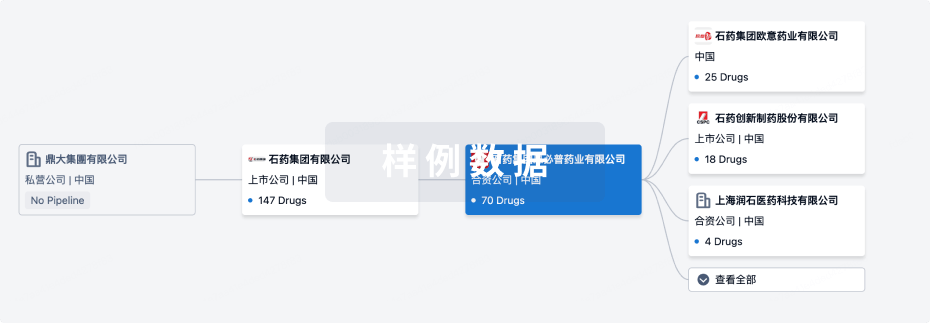
管线布局
2025年10月20日管线快照
管线布局中药物为当前组织机构及其子机构作为药物机构进行统计,早期临床1期并入临床1期,临床1/2期并入临床2期,临床2/3期并入临床3期
药物发现
3
8
临床前
登录后查看更多信息
当前项目
| 药物(靶点) | 适应症 | 全球最高研发状态 |
|---|---|---|
GAP112-RBD ( SARS-CoV-2 S protein ) | 冠状病毒感染 更多 | 临床前 |
GCS-12-6 | 炎症 更多 | 临床前 |
Pam3CSK4-RBD ( ACE2 ) | 新型冠状病毒感染 更多 | 临床前 |
DH4 ( SERT ) | 抑郁症 更多 | 临床前 |
GAP112 ( TLR4 ) | 新型冠状病毒感染 更多 | 临床前 |
登录后查看更多信息
药物交易
使用我们的药物交易数据加速您的研究。
登录
或
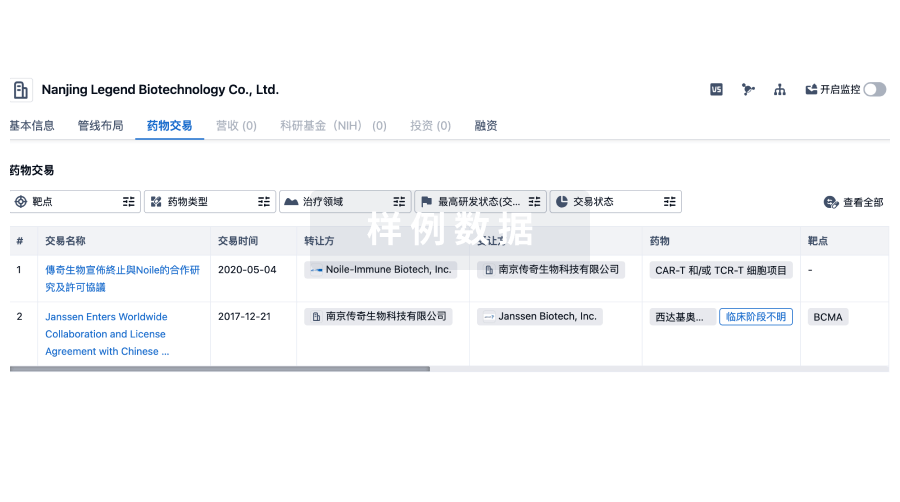
转化医学
使用我们的转化医学数据加速您的研究。
登录
或

营收
使用 Synapse 探索超过 36 万个组织的财务状况。
登录
或
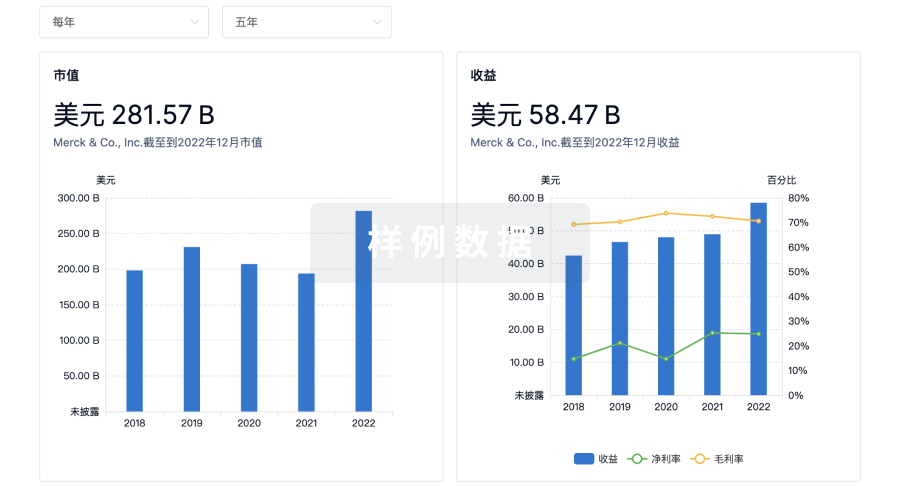
科研基金(NIH)
访问超过 200 万项资助和基金信息,以提升您的研究之旅。
登录
或

投资
深入了解从初创企业到成熟企业的最新公司投资动态。
登录
或
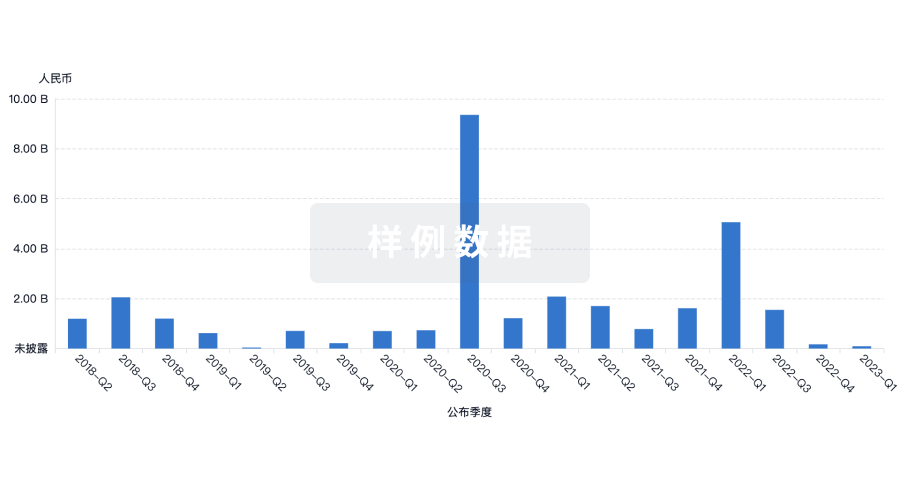
融资
发掘融资趋势以验证和推进您的投资机会。
登录
或
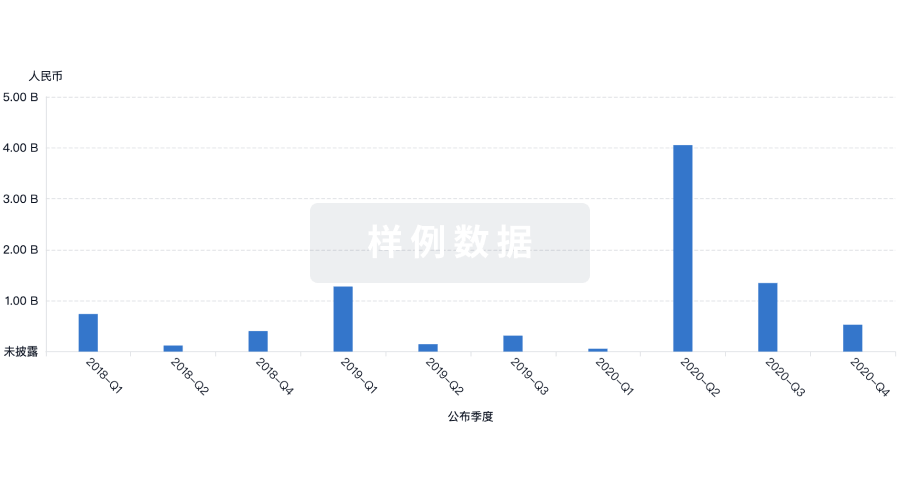
Eureka LS:
全新生物医药AI Agent 覆盖科研全链路,让突破性发现快人一步
立即开始免费试用!
智慧芽新药情报库是智慧芽专为生命科学人士构建的基于AI的创新药情报平台,助您全方位提升您的研发与决策效率。
立即开始数据试用!
智慧芽新药库数据也通过智慧芽数据服务平台,以API或者数据包形式对外开放,助您更加充分利用智慧芽新药情报信息。
生物序列数据库
生物药研发创新
免费使用
化学结构数据库
小分子化药研发创新
免费使用